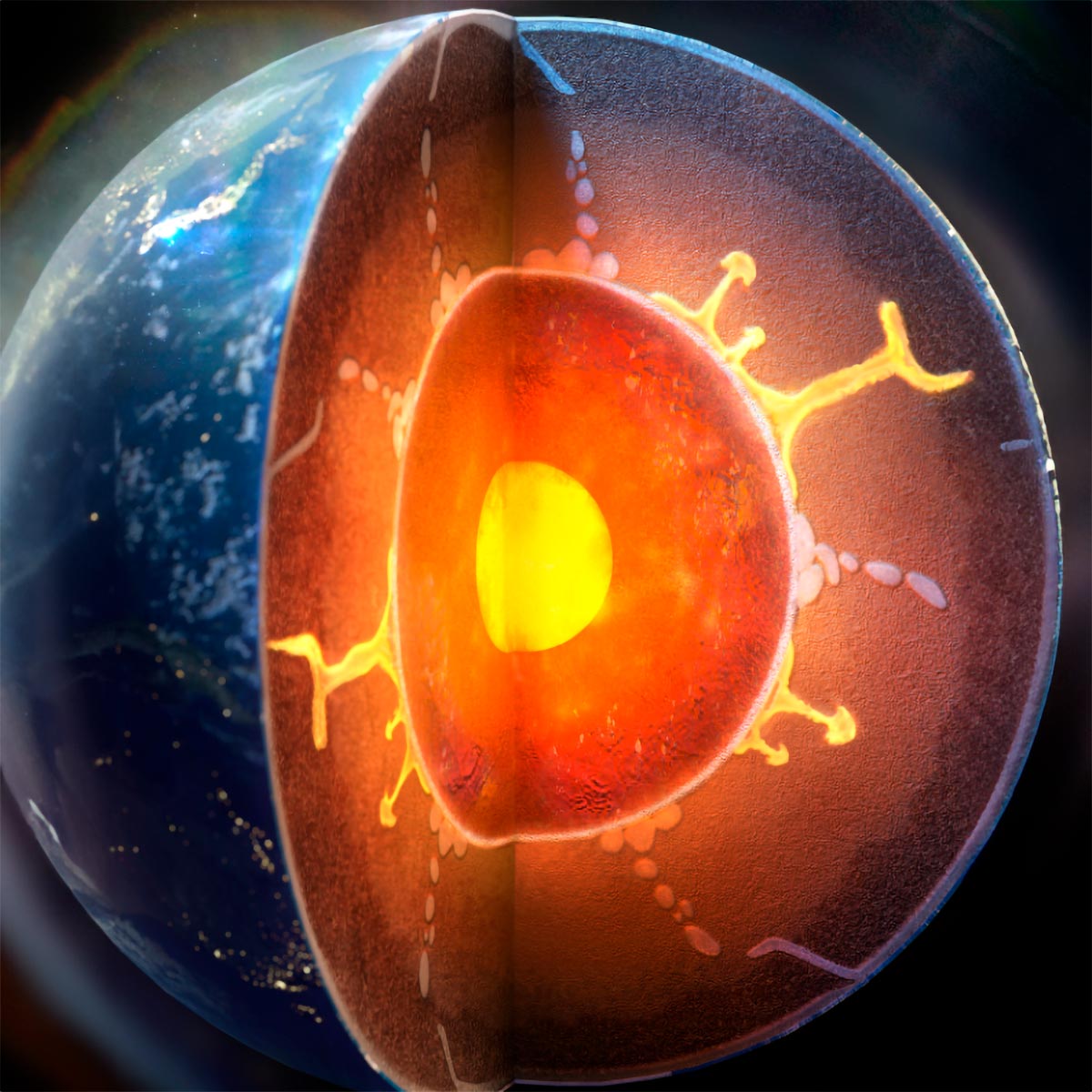
Illustration of silica crystals coming out from the liquid metal of the Earth’s outer core due to a water-induced chemical reaction. Credit: Dan Shim/ASU
A groundbreaking study uncovers the infiltration of Earth’s surface water to its core, leading to the alteration of its composition. This suggests a dynamic core-mantle interaction and a complex global water cycle.
Several decades ago, seismologists discovered a thin layer, known as the E prime layer, extending just over a few hundred kilometers. The hidden source of this layer has remained an enigma until now.
An international research team, including scientists Dan Shim, Taehyun Kim, and Joseph O’Rourke from Arizona State University’s School of Earth and Space Exploration, has disclosed that water from the Earth’s surface can penetrate deep into the planet. This causes a transformation within the metallic liquid core’s outermost region, creating a distinct, thin layer.
Their findings were recently published in Nature Geoscience.
Deep Water Transport Mechanism
Their research suggests that the Earth’s surface water has been carried deep into the planet over billions of years by descending tectonic plates. Upon reaching the core-mantle boundary, about 1,800 miles below the surface, the water initiates a significant chemical interaction, altering the core’s structure.

Illustration of Earth’s interior revealing subducting water and a rising plume of magma. At the interface where subducting water meets the core, a chemical exchange occurs to form a hydrogen-rich layer in the topmost outer core and dense silica in the bottom of the mantle. Credit: Yonsei University
Chemical Reactions at the Core-Mantle Boundary
Together with Yong Jae Lee of Yonsei University in South Korea, Shim and his team carried out high-pressure experiments indicating the chemical reaction of subducted water with core materials. This reaction creates a hydrogen-rich, silicon-depleted layer, modifying the topmost outer core into a film-like structure. Additionally, the reaction generates silica crystals that ascend and merge into the mantle. The modified liquid metallic layer is expected to be less dense, with reduced seismic velocities, consistent with abnormal traits observed by seismologists.
Core-Mantle Interaction and Global Significance
“Despite the long-held belief in minimal material exchange between Earth’s core and mantle, our recent high-pressure experiments reveal a different scenario. We have discovered that when water reaches the core-mantle boundary, it reacts with silicon in the core, producing silica,” Shim explained. “This finding, combined with our earlier observation of diamond formation from water reacting with carbon in iron liquid under extreme pressure, points to a far more dynamic core-mantle interaction, suggesting substantial material exchange.”
This discovery enhances our comprehension of Earth’s internal processes, indicating a more extensive global water cycle than previously acknowledged. The altered “film” of the core holds profound implications for the geochemical cycles linking the surface-water cycle with the deep metallic core.
Reference: “A hydrogen-enriched layer in the topmost outer core sourced from deeply subducted water” by Taehyun Kim, Joseph G. O’Rourke, Jeongmin Lee, Stella Chariton, Vitali Prakapenka, Rachel J. Husband, Nico Giordano, Hanns-Peter Liermann, Sang-Heon Shim and Yongjae Lee, 13 November 2023, Nature Geoscience.
DOI: 10.1038/s41561-023-01324-x
This study was conducted by an international team of geoscientists using advanced experimental techniques at the Advanced Photon Source of Argonne National Lab and PETRA III of Deutsches Elektronen-Synchrotron in Germany to replicate the extreme conditions at the core-mantle boundary.
Key members of the team included Kim, who initiated this project as a visiting PhD student and now works as a postdoctoral researcher at the School of Earth and Space Exploration, Shim, a professor at the School of Earth and Space Exploration, O’Rourke, an assistant professor at the School of Earth and Space Exploration, and Lee, who led the research team from Yonsei University, along with other research scientists from various institutions.
This work received support from the NSF Earth Science program.


